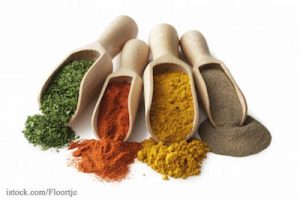The FDA has been analyzing a two year nationwide study to collect information on the presence of Salmonella in retail packages of spices consumers buy in supermarkets, ethnic markets, discount stores, and on the internet. There have been several recalls of spices and herbs in the past few years for Salmonella contamination, and a Salmonella outbreak linked to spices in Sweden sickened 178 people last summer. An FDA report in 2013 found that 12% of imported spices are tainted with pathogenic bacteria or filth.
 The draft risk profile found that the presence of pathogens such as Salmonella, and filth in spices is a “systemic challenge” and that the problem relates in part of poor or inconsistent use of appropriate controls to prevent contamination. In the study, spice shipments from 79 countries were examined for Salmonella. The FDA found that 37 of the 79 countries had Salmonella-contaminated shipments.
The draft risk profile found that the presence of pathogens such as Salmonella, and filth in spices is a “systemic challenge” and that the problem relates in part of poor or inconsistent use of appropriate controls to prevent contamination. In the study, spice shipments from 79 countries were examined for Salmonella. The FDA found that 37 of the 79 countries had Salmonella-contaminated shipments.
In fact, spice shipments offered for entry into this country had an overall presence for Salmonella of about 6.6% during the years 2007 to 2009, which is about twice the average of all other imported, FDA-regulated foods. And about 12% of spice shipments that come into the U.S. from 2007 to 2009 were adulterated with filth such as insects and animal hair.
The study also found that the FDA was missing key information about the level of contamination of spices sold at the retail level in this country. The public was asked for data but no information was offered. Many imported spices are treated after they are imported, so that 6.6% contamination rate does not reflect contamination in the product that consumers actually buy.
The FDA is analyzing this data but does not have results yet. Most of theU.S. spice supply is imported, which is why this study is important. The government sampled 7,249 spices, including basil, black pepper, oregano, paprika, red pepper (capsicum), coriander, cumin, curry powder, garlic, sesame seed and white pepper.
The Food Safety Modernization Act (FSMA) will help the FDA improve spice safety because the rules focus on preventing hazards and tightening controls in the supply chain, on products produced in this country and, importantly, in imported products. The agency has also increased inspections of spice manufacturing facilities.
The foreign supplier verification rule requires that importers verify the foods they import are produced using processes and procedures that ensure the same level of safety as food made in this country. Produce safety requirements may apply to certain types of spice plants, such as basil or coriander.
FDA is working with partners to develop a training center focused on supply chain management for spices and botanical ingredients. And the agency has staff permanently stationed in China, India, Europe, Latin America, Middle East and North Africa, and Sub-Saharan Africa. Indian is the leading country of origin for U.S. spice importation. The FDA has offices there in New Delhi and Mumbai.
At this time, the FDA is not recommending that consumers change their consumption or use of spices. In many cultures, spices are added during cooking rather than at the table. This heat treatment can reduce pathogen contamination, depending on the length of cooking time and the final temperature of the food.




